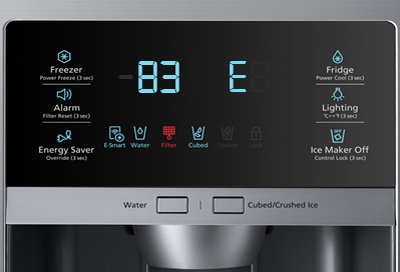
In the vast world of home appliances, these error codes are like SOS messages. They’re designed to help you identify the root of an issue without having to pull out your hair in frustration. When it comes to the “OE” code, we’re specifically dealing with a problem related to the water supply. This isn’t something you should panic about; instead, it’s a call to action. And you know what? With a bit of understanding and guidance, you can often resolve this issue yourself without immediately calling for professional help.
Understanding the “OE” Error Code
The “OE” error code on your Samsung refrigerator is a bit like a red flag alerting you to a water-related issue. When this code appears, it typically indicates a problem with the water overflow. Imagine if you left the tap running in your kitchen sink – eventually, the water would overflow, potentially causing a mess. The fridge is essentially highlighting there is excess water somewhere in the system.
In more technical terms, the “OE” code means the refrigerator is detecting excessive water in places it shouldn’t be, usually due to a clogged or malfunctioning drain line. Think of the drain line as a little highway for water to pass through. If there’s a roadblock, water backs up and can lead to this error code. It’s like your refrigerator’s way of saying, “Hey, my path is blocked, and I need a little help here!”
Now, why does this happen? It could be due to a buildup of food particles, ice, or even dirt that causes a clog. Just like when you accidentally drop a chunk of food in the sink, and water drains slower than usual. This same principle applies to your fridge, but don’t worry, it’s often an easy fix.
Troubleshooting and Fixing the Issue
Okay, so now you know what the “OE” error code means, but how do you go about fixing it? First off, let’s get into the nitty-gritty of troubleshooting this issue. Start by locating the drain line – usually found at the back of your fridge. It’s like finding the source of a river; once you know where it begins, you’re in a good position to resolve the issue.
To clear any blockages, you might want to start by gently flushing the drain line with warm water. This is similar to how you might use a plunger or drain cleaner to clear a sink. The warm water helps melt any ice or loosen up debris causing the blockage. Another handy trick is using a pipe cleaner or a thin, flexible brush to remove stubborn clogs – think of it as using a toothbrush to get rid of stuck food between your teeth.
If these steps don’t work, you could try defrosting the fridge. Simply unplug it and leave the doors open for a few hours. This allows any ice causing the blockage to melt away, similar to how the sun melts snow on a driveway. After the defrosting, check if the error code disappears. If not, it might be time to consult the refrigerator’s manual or call a professional for a deeper look into any missing or faulty components.
Preventative Tips to Avoid Future OE Errors
The best way to handle these error codes is to prevent them from happening in the first place. There are a few simple habits you can adopt to minimize the risk of the “OE” error code reappearing. Start by regularly checking and cleaning the area where the drain line is. It’s like regularly cleaning a coffee filter to ensure your coffee doesn’t taste bitter or have grounds in it.
Another tip is to avoid overstuffing your refrigerator. Imagine trying to fit too many things into a suitcase; it becomes difficult to manage, and things might spill out. If your fridge is too full, airflow can be restricted, which can contribute to condensation build-up and potential clogs in the drain system.
Lastly, make a habit of a periodic maintenance check-up every few months. This can be as simple as wiping down the interior, checking the seals, and ensuring there are no unusual noises or leaks. Just like you’d take your car for regular check-ups to ensure it runs smoothly, your refrigerator deserves the same kind of care.
In conclusion, while error codes like “OE” might seem daunting at first, they are manageable with a bit of patience and knowledge. With the right approach and regular maintenance, you can keep your Samsung refrigerator running smoothly and efficiently, ensuring it’s always ready to serve you and your family without a hitch!